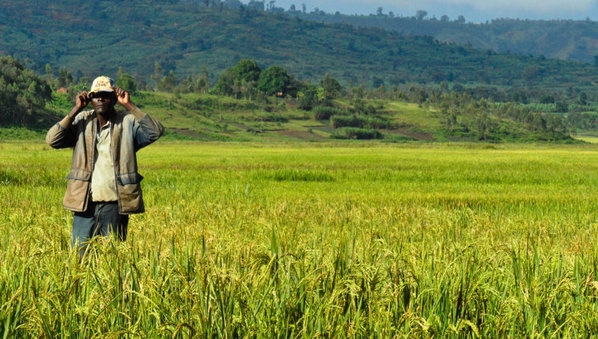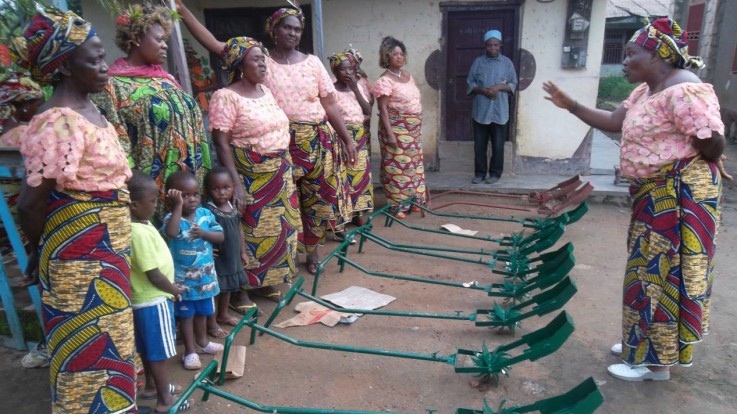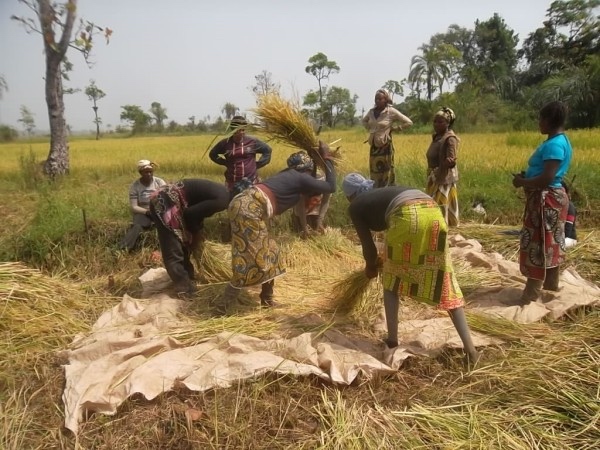
By Elias Ntungwe Ngalame
Cameroon rice farmers in the East and Northwest regions have recorded significant progress in rice production in the last decade thanks to technological knowledge transfer from China.
Chinese rice production scheme introduced in these regions since 2006 has recorded improvement in yields, control of dangerous weeds, the fight against crop diseases, destructive insects and climate stress, agriculture experts say.
Cameroon’s vast potential in rice and other cereals production is attracting not only investment from China with the setting up of some large-scale rice farms by the SINO-CAM IKO Agriculture Development Co. Ltd in Nanga Eboko in the East but also providing the opportunity for training and technology transfer in high breed rice farming by rice farmers in Ndop in the Northwest .
The scheme is not only boosting rice production in Cameroon but is also helping to improve on the income of rice farmers, as well as add value to the country’s second generation agriculture launched by the government since 2010.
“Cameroon rice farmers have really benefitted from training acquired from Chinese rice experts for quite some years now and this are impacting on the production. With high yield rice breed, and techniques to fight against diseases and the effects of climate change, many farmers have mapped out solution pathways to rice production,” says Bernard Njonga, President of ACDIC an NGO that defends the interest of farmers in Cameroon.
The Cameroon government says its rice production project with China that started in 2006 are a snapshot of Chinese engagement in agriculture in Cameroon, which is certainly not yet exhaustive. In the longer term, activities may accelerate, as more opportunities open up.
“We took the engagement to partner with the Chinese government in rice production not only because of their expertise in this sector but more because of their remarkable interest to invest and promote agriculture in Cameroon in general,” says Henry Eyebe Ayisi, Cameroon’s minister of agriculture and rural development in an interview.
Today, the Chinese ‘un-whitened’ rice is produced, packaged and sold in different markets in the country for FCFA 300 per kilogram.
The rice production is expanding to other areas in the country with about 6,000 hectares in Nanga Eboko and 4,000 hectares in Santchou in the West Region. The company officials say they are producing over 100,000 metric tonnes of rice to feed over 600,000 people and providing employment to some 1,000 workers.
The rice production project is the fruit of the Sino-Cameroon relations especially in agriculture. The partnership agreement was signed between the Ministry of Agriculture and Rural Development and the Integrated Industry-Commerce Corporation of the Shaanxi Land Reclamation and State Farms, China in 2006.
According to the agreement the latter was granted 10,000 hectares of land for the production, processing and marketing of rice. The agreement was accompanied by the Chinese government’s aid package of 40,000,000 RMB or FCFA 2,8 billion to revive Cameroon’s vast potential in agriculture.
According to the ministry of agriculture,a major offshoot of the partnership agreement was the creation of the subsidiary of the Shaanxi Company in Cameroon under the name SINO-CAM IKO Agriculture Development Co. Ltd. Besides stepping up production, SINO-CAM IKO has, under the stewardship of Yang Haomin, scored several successes in research, improvement of yields, control of dangerous weeds and the fight against crop diseases and destructive insects.

To spread this knowledge and transfer technology throughout Cameroon, a Pilot Centre for Agricultural Technologies training was constructed in 2009 in Nanga Eboko that has helped significantly to empower young rice farmers especially women with innovative skills, demonstration and promotion of agricultural techniques.
Over 1000 local workers in the East region and some 600 from the Northwest have been trained so far in rice farming techniques including the management of agricultural machines and hydraulics.
“Thanks to the Sino-Cameroon cooperation in rice production, local production scale has improved in quantity and quality,” Minister Eyebe Ayissi acknowledges.
Improvement in local rice production in the country has since reduced importation as the Chinese breed ‘un-whitened’ rice comes to add to other local breed, Ndop and SAMRY rice produced in the East, Northwest and the Northern region respectively.
Added to the Ndop Rice that is produced by the Upper Noun Valley Development Authourity UNVDA or the SAMRY rice that comes from the Northern region of Cameroon, the Pakistani, Thailand or Chinese rice now sells in many Cameroonian local markets.
Experts say Cameroon has enormous potentials and high arable fertile land for rice cultivation but records from the ministry of Agriculture and Rural Development says the country produces only 100.000 tons of rice far below the 300.000 tons on demand annually.
“Cameroon is endowed enormous resources especially arable fertile land and human resources to produce enough rice to meet the country’s demand and even export to neighboring countries. The farmers just need the right training skills and material support,” says Zachee Nzohngandembou, coordinator of the Center for Environment and Rural Transformation, CERUT, an NGO that works with farmers in Cameroon.
With skills learned from the Chinese training programmes in the agro-sector some rice farmers are now able to maximize production potentials with the introduction of two cropping seasons, he says.
“ This means they can now produce 75,000 tons of rice on a surface area of 15,000 hectares, which was not the case before the training,” says Nzohngandembou.
On another score, the SEMRY project in the Northern region that produces 70 to 80% of Cameroon home-consumed rice announced the acquisition of a rice paddy transformation machine with a ten ton capacity. SEMRY is in record for producing over 70,000 to 80,000 tons of rice annually.
According to experts, Chinese role in agriculture in Africa – in terms of business investment, technology transfer, demonstration efforts, and training – is growing, and shaping perceptions. The Chinese Agricultural Technology Development Centers have flagship investments programmes for example is helping many African countries including Cameroon improve production.
There are now 23 across Africa, funded by the Chinese Ministry of Commerce under their aid programme, Chinese officials in Cameroon say.
These institutions are run mostly by companies and linked to a commercial model for training and technology demonstration and sale.
The training of government officials is as well an important aspect of the Chinese engagement in Africa. Over 10,000 are trained in China each year, many in agriculture. This far exceeds any training initiative of any western aid programme the officials said.

Challenges
The Chinese have not only trained Cameroon rice farmers but equally own rice plantations with many Cameroonians as their workers. Over ten years down the line since Cameroon partnered with China in production, transformation and trade of agricultural products especially rice, the project has not been without hiccups. Cameroon workers in most of the Chinese owned plantations say they are over worked for little pay.
“Working in a Chinese plantation means running eight or ten hours nonstop under the sun and the rain for 1,000 Fcfa [1,5 euros] a day” says Zang Dieudonne a rice farmer in Nanga-Eboko.
This remuneration he says does not correspond to the minimum guaranteed wage in Cameroon, which is 28,216 Fcfa per month [about 43 euros].
They also complained of very strict laws for the workers in the field.
“Harvesting any crop is forbidden,” says a taxi driver who has worked for the Chinese firm for a short period. “If they catch you with some rice in your pocket, you are directly sent to the police and accused of theft,” says the former rice farm worker.
But Sino Cam officials in Nganga Eboko reject the charges of exploitation.
“We are still in the experimental phase and we are asking our workers to do more so that they may earn more, but they prefer to cheat us. They say they are here to make money – but they need to work to make the company grow,” Zhao, one of the coordinators in the Sino Cam rice plantation in Nanga Eboko.
Local government officials in the area however decry the non involvement of local government in the project.
“The running of a Chino-Cameroon rice farm project in our area is a good initiative. But the local government unfortunately is not part of the project. This has created lack of transparency and information flow between the local population and the company and this is poisoning relationships between citizens,consumers and the company, says the mayor of Nanga Eboko, Romain Roland Eto
The urban association that defends the interests of farmers, ACDIC, says the non involvement of the local government in the project is dangerous and represents a breach in the rights of the local population.
“When land is sold to foreign buyers for agriculture projects without the involvement of the local government guarantee the interest of the indigenous population will be protected,” says Bernard Njonga, ACDIC President.
But Chinese officials say everything has been done to protect the interest of the local population in all agriculture projects by China in Cameroon.
“China supports Cameroon’s push for self-driven, sustainable agriculture and also supports and protects the interest of local farmers” said Chinese Ambassador to Cameroon Wo Ruidi, at a cooperation signing agreement with the Cameroon government in 2014.
He added that the two sides should enhance people-to-people exchanges to deepen mutual understanding and cement friendship especially among the youths and women.
“China is willing to help Cameroon train more professionals for its social and economic development,” he said.
Building stronger farm organizations
Stakeholders in the rice sector in Africa pointed at the 3rd Africa Rice Congress held in the Yaounde-Cameroon in October 2015 that there was need to build a strong farmers organization in the continent to address the crucial element of funding for rice research, seed production in the continent.

“Prospects for increasing Africa’s rice yields are enormous. We’re already doing well with the Maputo Declaration, allocating 10 percent of our national budgets to agriculture and a significant proportion of that is going to rice production. But we need a strong farmer’s organization to address the crucial issues of funding research, seed production and marketing,” said Gambia’s minister of agriculture, Dr. Solomon Owens, at the third Africa Rice Congress in Yaounde.
“The opportunities for Africa rice farmers are there. The land is there, the water is there, the farmers are prepared to increase their production. So, it’s for research to give the technologies, give the varieties and for the policymakers to come up with strong and bold policies and financing opportunities,” Owens said.
He cited the examples of countries in West Africa and Egypt that are expected to drive growth with a robust production recovery, and a target of 30 million tons by 2020.
Meanwhile, the Food and Agriculture Organization’s Rice Market Monitor predicts rice harvests across the continent that will exceed 27 million tons by 2017, a two-percent jump from 2015/2016,an indicator of gradual strides towards rice independence in the continent.











